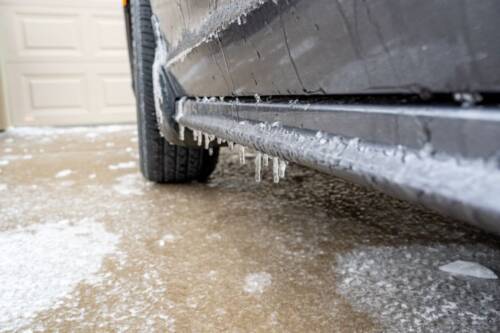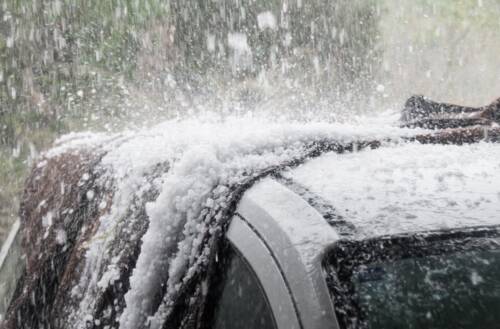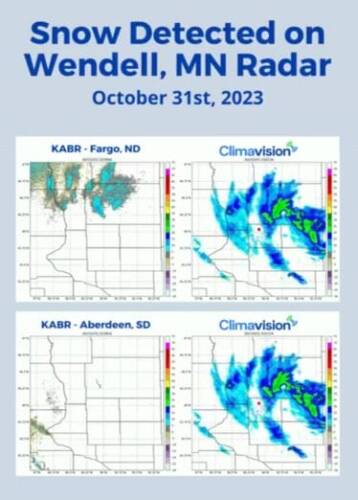Frozen Precipitation and its Impact on Business Industries
As we approach winter, it is important to cover winter weather events that are likely to occur across the continental United States. Several of these events may come in the form of frozen precipitation. Frozen precipitation, a meteorological phenomenon characterized by the formation of ice crystals or frozen water droplets in the atmosphere, plays a significant role in shaping our weather patterns and can have a profound impact on various industries. In this blog post, we will investigate what frozen precipitation is, the different forms it can take, what causes these variations, when and where it is most likely to occur, and how it disrupts different business sectors.
What is Frozen Precipitation?
Frozen precipitation refers to any form of water that falls from the sky and reaches the ground in a solid, frozen state. This includes a variety of frozen particles, such as snow, sleet, and freezing rain, each with distinct characteristics and formation processes.
Types of Frozen Precipitation
Snow
Snow consists of ice crystals that form in the clouds and fall to the ground as flakes. Snow forms when the temperature in the clouds is at or below freezing (32°F or 0°C) and temperatures near the ground are below freezing, or close to it. The shape and size of snowflakes depend on factors such as temperature, humidity, and atmospheric pressure. For example, snow that falls in an area with temperatures closer to the freezing point typically has larger, more moist snowflakes than an area with much colder temperatures. It typically occurs in cold climates and regions with low temperatures.

Sleet
Sleet forms when there is a warm layer aloft, melting snowflakes into raindrops, followed by a deep layer of freezing air near the ground. Raindrops freeze into ice pellets before reaching the surface. The main differentiating factor from freezing rain is that sleet is a solid before it hits the surface. Sleet can create hazardous driving conditions and icy surfaces.

Freezing Rain
Freezing rain occurs when a shallow layer of cold air near the surface is beneath a layer of warmer air aloft. Raindrops fall through the warm layer, turn into supercooled liquid, and freeze upon contact with surfaces at or below freezing. The raindrops’ contact with the freezing surface creates a glaze of ice, known as “ice storms.” Freezing rain can lead to power outages, damage to trees, and treacherous travel conditions.

Hail
Hail is a type of frozen precipitation characterized by hard, spherical, or irregularly shaped ice pellets. Hailstones are formed within strong thunderstorms when updrafts carry raindrops into extremely cold upper layers of the atmosphere, causing them to freeze. As these frozen raindrops are repeatedly lifted and carried through the storm, additional layers of ice accumulate, resulting in hailstones of varying sizes. Hail can be small, like peas, or large, reaching the size of golf balls or even larger.

When and Where is Frozen Precipitation Most Likely to Occur?
The occurrence of frozen precipitation is closely tied to geographical location and seasonal variations. Here are some key points:
Geographical Location
Snow is most common in regions with cold winters and significant moisture, such as the northern United States, Canada, and parts of Europe.
Sleet and freezing rain often affect areas where temperatures hover around the freezing point during winter, like the U.S. Southern Plains and the southeastern United States.
Hail, like tornadoes, has a specific area of the United States that it is most likely to occur. Nebraska, Colorado, and Wyoming usually have the most hailstorms. The area where these three states meet – “hail alley” – averages seven to nine hail days per year.
Seasonal Variations
Frozen precipitation is most likely during the winter months when temperatures are at or below freezing. However, it can occur in transitional seasons, such as late fall and early spring, when temperature fluctuations are common.
Hail, unlike other frozen precipitation, is actually more likely to occur in spring and early summer months that boast strong, convective thunderstorms, but can also occur all year long.
Impact on Business Industries
Frozen precipitation can have a profound impact on various business sectors, causing disruptions that range from logistical challenges to financial losses. Here’s how different industries are affected:
Transportation
Airlines face flight delays and cancellations due to icy runways and snow accumulation. Road transportation experiences challenges, with hazardous driving conditions leading to accidents, road closures, and supply chain disruptions. Rail and public transportation can be affected, leading to delays in passenger and cargo services.
Agriculture
Farmers must protect crops and livestock from freezing temperatures and sizeable hail, both of which can damage or destroy crops and lead to increased heating costs for animal shelters. Frozen precipitation can also disrupt the transportation of agricultural products, affecting distribution and supply chain logistics.
Energy
Frozen precipitation can lead to power outages as ice accumulates on power lines and utility equipment. Just a half an inch of ice can cause severe damage to trees and power lines, often resulting in numerous downed trees and widespread power outages that might last for days. The most destructive ice storms produce ice amounts of an inch or greater. Utilities often need to allocate additional resources to repair and maintain infrastructure during these winter storms.
How can Businesses Mitigate Frozen Precipitation Risk?
Improved weather radar coverage, more accurate Numerical Weather Prediction (NWP) models, and the integration of Artificial Intelligence (AI) can significantly assist businesses in mitigating the impact of frozen precipitation. Here’s how each of these elements contributes to better preparedness and decision-making:
Improved Weather Radar Coverage
Enhanced radar coverage provides early detection of approaching frozen precipitation events, giving businesses more time to prepare and respond. This allows for proactive measures such as adjusting operations, scheduling, and logistics to minimize disruptions.
Modern dual polarity radar systems can differentiate between various types of precipitation, including rain, snow, sleet, and freezing rain. This information is critical for businesses to tailor their responses and make informed decisions based on the specific weather conditions.
Radar coverage helps businesses track the intensity of frozen precipitation events. This information is valuable for assessing the potential severity of disruptions and adapting plans accordingly. Improved radar technology also provides more accurate information about the location and movement of precipitation. Businesses can use this data to pinpoint affected areas and allocate resources effectively.
Climavision’s Wendell Minnesota radar provided a great example of improved precipitation detection. On October 31st, one inch of snow fell near Climavision’s first Minnesota radar installation in Grant County, per local weather station reports. As seen in the following radar loops, Climavision’s radar detected snow for several hours, while the closest NEXRAD locations missed the majority of the snowfall event. It is important to note that radar coverage in Minnesota is sporadic, making Climavision radar installations ever important.

More Accurate Numerical Weather Prediction (NWP) Models
Advanced NWP models increase forecast accuracy, allowing businesses to prepare for frozen precipitation events well in advance. This enables proactive measures, such as adjusting staffing levels, inventory, and transportation schedules. Accurate NWP models enable businesses to develop and evaluate different scenarios based on forecasted weather conditions. This helps in contingency planning and risk assessment.
High-resolution NWP models offer detailed information about temperature, humidity, wind patterns, and precipitation types. Businesses can use this data to make precise decisions, such as whether to deploy de-icing equipment or reroute shipments. By relying on NWP models, businesses can allocate resources more efficiently, such as optimizing energy consumption, managing inventory levels, and planning workforce scheduling during adverse weather conditions.
At Climavision, we push the boundaries of forecasting by crafting our own advanced Numerical Weather Prediction (NWP) Models, meticulously calibrated to account for the evolving landscape of extreme weather patterns in our changing atmosphere. Our Horizon AI weather forecasting product suite encompassing Horizon AI Global, HIRES, Point and Subseasonal to Seasonal models.
Integration of AI
AI can process vast amounts of real-time weather data from radar and NWP models quickly. It can identify patterns, anomalies, and trends that human operators might miss. This allows businesses to make data-driven decisions in real-time.
For immediate events, AI-driven systems can send automated alerts and notifications to key stakeholders, ensuring that decision-makers are aware of changing weather conditions and can act promptly.
In the long term, AI models can continuously learn and adapt based on historical weather data and past business responses. This iterative learning process allows for increasingly accurate predictions and more effective mitigation strategies over time.
Climavision’s AI and computational capabilities enable us to assimilate vast amounts of data and tailor our Horizon AI NWP model forecasts to precisely match your unique use cases.
Avoid Business Freezes With Advanced Weather Technology
Frozen precipitation, with its various forms like snow, sleet, and freezing rain, is a weather phenomenon that impacts different industries in unique ways. Understanding the causes, occurrence patterns, and impacts of frozen precipitation is essential for businesses and individuals alike to prepare and mitigate its disruptions. From transportation challenges to agricultural concerns and energy issues, frozen precipitation’s effects on various sectors underscore the importance of planning and adaptation in the face of changing weather conditions. The combination of improved weather radar coverage, more accurate NWPs, and the integration of AI provides businesses with enhanced tools for mitigating the impact of frozen precipitation. These technologies enable businesses to make timely, data-driven decisions, optimize resource allocation, and improve overall resilience to adverse weather conditions. By leveraging these advancements, businesses can reduce disruptions, minimize losses, and maintain operational continuity even in the face of challenging weather events. If you’d like to learn more about how Climavision’s advancements in these weather technology areas can help your organization, contact us.

